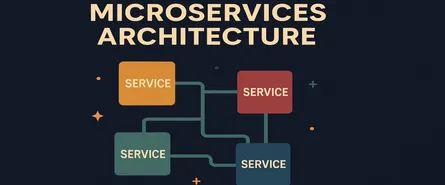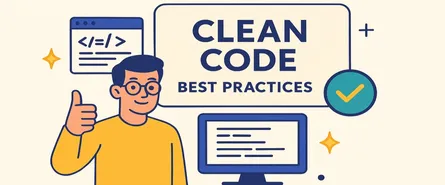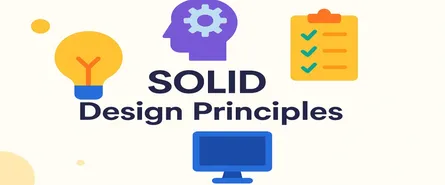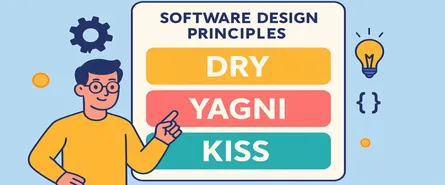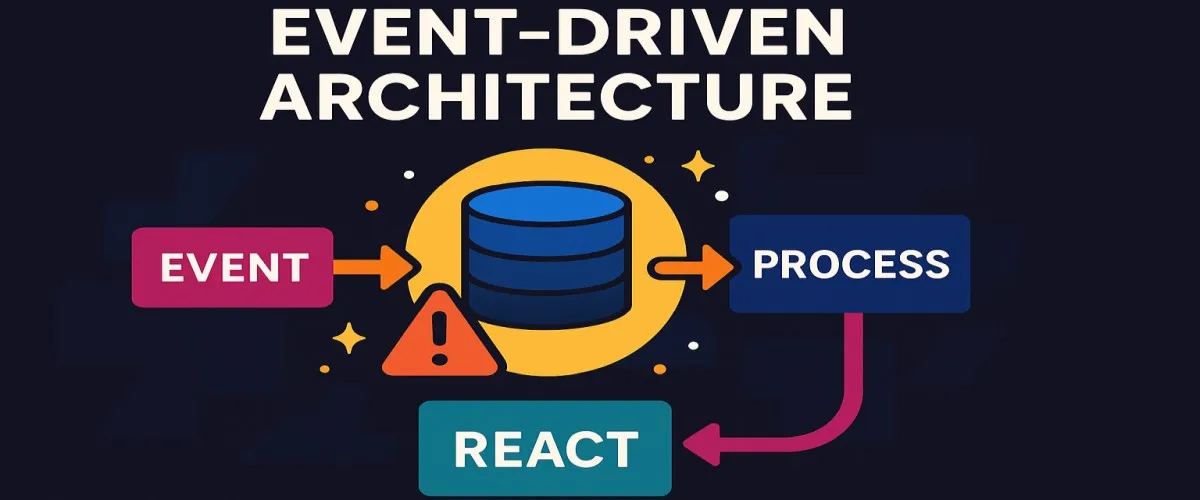
Event-Driven Architecture for Beginners: .NET and C# Examples
1. Introduction: Moving Beyond the Request-Response Paradigm
1.1 The ‘Why’ for Architects: Building Resilient, Scalable, and Loosely Coupled Systems
Most software architects start their journey with traditional, synchronous architectures. The classic example is the request-response pattern: a client sends a request, a server processes it, and a response is returned. While this model is simple and familiar, it comes with hidden costs as your systems grow.
Think about modern digital businesses. E-commerce platforms, financial systems, social media—these all demand resilience, real-time responsiveness, and effortless scaling. The moment one part of a monolith slows down, the whole system can suffer. If your business suddenly spikes in popularity, that old synchronous workflow can buckle under the load.
Event-Driven Architecture offers a solution. Instead of tightly coupled workflows where each component must wait for the next, EDA turns your application into a collection of loosely connected services. Each reacts to events—immutable facts about something that has already happened. This model brings several key advantages:
- Resilience: A slow or unavailable component doesn’t break the entire system. Events are durable, and services can recover or replay events after outages.
- Scalability: Consumers can be scaled independently, focusing resources where they’re most needed.
- Loose Coupling: Components are connected through events, not direct calls. This allows teams to evolve and deploy services independently.
If you’re an architect facing growing complexity, reliability challenges, or the need for rapid scaling, EDA offers a robust architectural solution.
1.2 Monolith vs. EDA: A High-Level Comparison of Communication Patterns
To understand where EDA fits, let’s briefly compare it to the more traditional monolithic approach.
Monolithic Application: A single, tightly integrated codebase. Communication is mostly in-process—function calls or direct class references. This simplicity is its strength and its Achilles heel. Change is hard, scaling is blunt (the whole app scales together), and failure in one part can cascade.
Event-Driven Architecture: An application is broken down into discrete, autonomous services. These services communicate by emitting and consuming events, usually through a message broker. Instead of waiting for a response, a service emits an event and moves on. Other services pick up the event and react in their own time.
Key Differences at a Glance:
| Aspect | Monolith | Event-Driven Architecture |
|---|---|---|
| Communication | Direct, synchronous | Indirect, asynchronous |
| Coupling | Tight | Loose |
| Failure handling | Often cascades | Isolated, with retries |
| Scalability | All-or-nothing | Per-service, granular |
| Evolvability | Hard (requires coordinated deploys) | Flexible, independent deploys |
1.3 Who This is For: Architects Exploring EDA with .NET
This article is for architects and senior developers—those who are ready to modernize their application design but are new to the principles and patterns of Event-Driven Architecture. The focus here is on core EDA concepts, practical .NET implementations, and lessons you can apply immediately—even if you’re just beginning your EDA journey.
We’ll move step by step, ensuring foundational concepts are clear before diving into C# code examples. Whether your background is ASP.NET, enterprise apps, or cloud-native microservices, the examples and insights are tailored for you.
Let’s start by understanding the essential building blocks of an event-driven system.
2. The Core Components of Event-Driven Systems
What does an event-driven system actually look like? The mental model is straightforward: producers publish events, consumers react to them, and a message broker connects the dots. But the details matter.
2.1 Events: What They Are (and Aren’t)
At its heart, an event is a record of something that has already happened. Events are facts. They are immutable, timestamped, and describe state changes or actions in your business domain.
Events are not commands. This distinction is vital for architects. A command is an instruction: “Place this order.” An event is a statement of fact: “Order was placed.” This difference shapes your code, your workflows, and your understanding of system behavior.
2.1.1 Example: Command vs. Event in E-Commerce
Suppose you’re designing an order management system. Here’s how the command/event distinction looks in C#:
// A command: the user's intention
public record PlaceOrderCommand(Guid OrderId, string CustomerEmail, List<OrderItem> Items);
// An event: what actually happened
public record OrderPlacedEvent(Guid OrderId, string CustomerEmail, List<OrderItem> Items, DateTime PlacedAt);Notice the key differences:
- The command is a request. The event is a fact.
- Events are typically immutable—once published, they don’t change.
- Commands may fail; events only exist if something actually happened.
Understanding this distinction keeps your system’s behavior clear and auditable.
2.2 Producers (or Publishers): The Source of Events
A producer is any component that creates and publishes events. In .NET, this could be a web API, a background worker, or a service handling business logic. Whenever a significant action is completed—such as an order being placed or a payment processed—the producer emits an event.
For example, after a customer successfully checks out, your Orders API might publish an OrderPlacedEvent to a message broker.
2.3 Consumers (or Subscribers): Services that React to Events
Consumers are services or components that subscribe to and process events. They don’t care who produced the event—only that it’s relevant to their responsibilities.
For instance, a Notification Service might listen for OrderPlacedEvent messages and send a confirmation email to the customer. A separate Analytics Service could listen to the same event and update business metrics. Multiple consumers can react to the same event independently.
2.4 The Message Broker (or Event Bus): The Central Nervous System
A message broker is the infrastructure layer that receives events from producers and delivers them to interested consumers. It’s the glue that holds your event-driven system together.
Popular brokers include RabbitMQ, Apache Kafka, Azure Service Bus, and AWS SNS/SQS. The broker abstracts away point-to-point wiring, enabling loose coupling and horizontal scaling.
Think of the broker as a postal service. Producers drop off their mail (events), and the postal system delivers them to all relevant recipients (consumers), reliably and efficiently.
3. Choosing Your Message Broker in the .NET Ecosystem
A key architectural decision is choosing the right broker. Each option comes with trade-offs in terms of throughput, durability, operational complexity, and integration with your stack.
3.1 A Quick Survey of Popular Options
3.1.1 RabbitMQ: The Versatile Workhorse
RabbitMQ is a well-established, open-source broker that implements the AMQP protocol. It’s renowned for its simplicity, flexible routing (queues and exchanges), and wide .NET support.
Best for: Traditional messaging, reliable delivery, complex routing scenarios, most general-purpose needs.
3.1.2 Apache Kafka: The High-Throughput Event Stream
Kafka isn’t just a broker—it’s an event streaming platform. It shines in high-throughput, real-time analytics, and event sourcing use cases. Kafka is built for scale and durability, storing events for days or even weeks.
Best for: Event streaming, log aggregation, real-time analytics, and when you need to replay streams of events.
3.1.3 Azure Service Bus & Azure Event Hubs: PaaS for the Cloud
If your system is cloud-based or hybrid, Azure’s managed messaging services offer seamless integration and enterprise-grade durability.
- Azure Service Bus: Reliable messaging with rich features, suitable for decoupled enterprise applications.
- Azure Event Hubs: Focused on high-throughput streaming and ingestion of large numbers of events.
Best for: Cloud-native applications, minimizing infrastructure overhead, and leveraging Azure’s ecosystem.
3.2 Architectural Considerations: Feature Comparison Table
Choosing a broker isn’t just about popularity. Each platform brings different strengths. Here’s a comparison to guide your decision:
| Feature | RabbitMQ | Apache Kafka | Azure Service Bus | Azure Event Hubs |
|---|---|---|---|---|
| Throughput | Moderate-High | Very High | High | Very High |
| Ordering | Per-queue | Per-partition | Per-session | Per-partition |
| Persistence | Yes (queues) | Yes (log, durable) | Yes (queues) | Yes (log) |
| Delivery | At-least-once | At-least-once | At-least-once | At-least-once |
| Management | Moderate | Complex | Simple (PaaS) | Simple (PaaS) |
| .NET Support | Excellent | Excellent | Native | Native |
| Use Cases | General messaging | Event streaming | Enterprise messaging | Data ingestion |
Consider:
- RabbitMQ for most line-of-business and classic microservice workloads
- Kafka when you need long-lived event logs, streaming analytics, or big data pipelines
- Azure Service Bus for enterprise integration in the cloud
- Azure Event Hubs for real-time telemetry and analytics at cloud scale
4. A Practical “Hello, World!” in .NET
Let’s make this real. We’ll create a simple event-driven workflow using .NET and C#. Imagine an e-commerce platform: when an order is placed, a notification is sent. We’ll use RabbitMQ as our broker for approachability, but the principles apply to any modern broker.
4.1 Scenario: E-Commerce Order Triggers a Notification
Goal:
- A user places an order.
- The system emits an
OrderPlacedEvent. - A notification service consumes the event and simulates sending an email.
This pattern is the foundation of real-world EDA—think payments, inventory updates, analytics, and more.
High-Level Flow
- Order Service: Receives API request, creates the order, publishes
OrderPlacedEvent. - Message Broker (RabbitMQ): Receives and stores the event.
- Notification Service: Subscribes to
OrderPlacedEvent, reacts by sending an email.
Let’s walk through each step, using modern .NET patterns and features.
4.2 Producer: Publishing an Event in .NET (with C# Example)
Suppose you have a basic ASP.NET Core Web API that handles order creation. Once an order is processed, it needs to publish an OrderPlacedEvent to RabbitMQ.
First, ensure you have the required NuGet packages:
RabbitMQ.ClientSystem.Text.Json(for serialization)
Example: Publishing an Event
using System.Text;
using System.Text.Json;
using RabbitMQ.Client;
public class OrderPlacedEvent
{
public Guid OrderId { get; set; }
public string CustomerEmail { get; set; }
public DateTime PlacedAt { get; set; }
public List<OrderItem> Items { get; set; }
}
public class OrderEventPublisher
{
private readonly IConnection _connection;
private readonly IModel _channel;
private readonly string _exchangeName = "order.exchange";
public OrderEventPublisher()
{
var factory = new ConnectionFactory { HostName = "localhost" };
_connection = factory.CreateConnection();
_channel = _connection.CreateModel();
_channel.ExchangeDeclare(_exchangeName, ExchangeType.Fanout);
}
public void PublishOrderPlacedEvent(OrderPlacedEvent orderEvent)
{
var messageBody = JsonSerializer.Serialize(orderEvent);
var body = Encoding.UTF8.GetBytes(messageBody);
_channel.BasicPublish(
exchange: _exchangeName,
routingKey: "",
basicProperties: null,
body: body);
}
public void Dispose()
{
_channel?.Dispose();
_connection?.Dispose();
}
}Usage in Controller:
[ApiController]
[Route("api/orders")]
public class OrdersController : ControllerBase
{
private readonly OrderEventPublisher _publisher;
public OrdersController(OrderEventPublisher publisher)
{
_publisher = publisher;
}
[HttpPost]
public IActionResult PlaceOrder([FromBody] OrderDto order)
{
// Business logic to save order
var orderId = Guid.NewGuid();
var orderEvent = new OrderPlacedEvent
{
OrderId = orderId,
CustomerEmail = order.CustomerEmail,
PlacedAt = DateTime.UtcNow,
Items = order.Items
};
_publisher.PublishOrderPlacedEvent(orderEvent);
return Ok(new { orderId });
}
}This is a bare-bones example. In production, manage your RabbitMQ connections carefully, use dependency injection, and handle exceptions robustly.
4.3 Consumer: Subscribing to Events and Reacting (C# Example)
The Notification Service could be a simple .NET Worker Service that subscribes to OrderPlacedEvent messages from RabbitMQ and simulates sending an email.
Example: Consuming an Event
using System.Text;
using System.Text.Json;
using RabbitMQ.Client;
using RabbitMQ.Client.Events;
public class NotificationService
{
private readonly string _exchangeName = "order.exchange";
private readonly string _queueName = "notification.queue";
private readonly IConnection _connection;
private readonly IModel _channel;
public NotificationService()
{
var factory = new ConnectionFactory { HostName = "localhost" };
_connection = factory.CreateConnection();
_channel = _connection.CreateModel();
_channel.ExchangeDeclare(_exchangeName, ExchangeType.Fanout);
_channel.QueueDeclare(_queueName, durable: true, exclusive: false, autoDelete: false);
_channel.QueueBind(_queueName, _exchangeName, "");
}
public void StartListening()
{
var consumer = new EventingBasicConsumer(_channel);
consumer.Received += (model, ea) =>
{
var body = ea.Body.ToArray();
var json = Encoding.UTF8.GetString(body);
var orderEvent = JsonSerializer.Deserialize<OrderPlacedEvent>(json);
Console.WriteLine($"[NotificationService] Sending email for Order {orderEvent.OrderId} to {orderEvent.CustomerEmail}");
// Simulate sending email...
};
_channel.BasicConsume(queue: _queueName, autoAck: true, consumer: consumer);
}
}Usage:
public static void Main(string[] args)
{
var notificationService = new NotificationService();
notificationService.StartListening();
Console.WriteLine("Notification Service started. Press [enter] to exit.");
Console.ReadLine();
}This service can be independently scaled and deployed. If you want multiple notification processors, simply run more instances of the worker.
4.4 High-Level Abstractions: MassTransit and NServiceBus
Working with raw broker APIs is instructive, but in production you’ll want higher-level libraries that manage many details for you—connection retries, serialization, error handling, and message routing.
MassTransit and NServiceBus are two leading open-source options for .NET.
Example: Using MassTransit
Add the following NuGet packages:
MassTransitMassTransit.RabbitMQ
Producer with MassTransit:
public interface IOrderPlaced
{
Guid OrderId { get; }
string CustomerEmail { get; }
DateTime PlacedAt { get; }
}
public class OrderEventPublisher
{
private readonly IBus _bus;
public OrderEventPublisher(IBus bus)
{
_bus = bus;
}
public Task PublishOrderPlacedAsync(IOrderPlaced orderPlaced)
{
return _bus.Publish(orderPlaced);
}
}Consumer with MassTransit:
public class OrderPlacedConsumer : IConsumer<IOrderPlaced>
{
public Task Consume(ConsumeContext<IOrderPlaced> context)
{
var evt = context.Message;
Console.WriteLine($"[MassTransit] Sending email for Order {evt.OrderId} to {evt.CustomerEmail}");
// Simulate sending email
return Task.CompletedTask;
}
}Configuration (e.g., in Program.cs):
builder.Services.AddMassTransit(x =>
{
x.AddConsumer<OrderPlacedConsumer>();
x.UsingRabbitMq((context, cfg) =>
{
cfg.Host("localhost");
cfg.ConfigureEndpoints(context);
});
});Benefits of MassTransit and NServiceBus:
- Automated retries and error queues
- Consistent serialization/deserialization
- Easy support for sagas and complex workflows
- Abstractions for various brokers, making switching easier
5. Key Architectural Patterns in EDA
Understanding Event-Driven Architecture means going beyond simply wiring up producers and consumers. Certain patterns emerge as you scale your system or try to solve more sophisticated problems. These patterns allow you to maximize the benefits of EDA while managing complexity.
5.1 Publish-Subscribe (Pub/Sub): The Fundamental One-to-Many Pattern
At the heart of most event-driven systems lies the publish-subscribe (Pub/Sub) pattern. It’s the backbone of loosely coupled architectures. The concept is simple but powerful: a producer publishes events to a topic or exchange, and any number of consumers subscribe to receive those events.
How It Works
- Producer: Publishes an event—say,
OrderPlaced—to a topic (in Kafka), exchange (in RabbitMQ), or subject (in other brokers). - Consumers: Subscribe to that topic or queue. Each receives a copy of every event.
The crucial point? Producers and consumers don’t need to know about each other. The broker handles all routing and delivery. If you add more consumers, you don’t need to touch the producer’s code.
Practical Example
If your e-commerce platform emits an OrderPlacedEvent, different services can react independently:
- Notifications Service: Sends a confirmation email
- Inventory Service: Updates stock levels
- Analytics Service: Logs the order for reporting
All these services get notified simultaneously without direct coupling.
Pub/Sub in .NET
Libraries like MassTransit or NServiceBus abstract the subscription process, letting you focus on the event contracts and business logic. Here’s a simplified MassTransit example to illustrate:
public class OrderPlacedConsumer : IConsumer<OrderPlacedEvent>
{
public Task Consume(ConsumeContext<OrderPlacedEvent> context)
{
// React to the event
return Task.CompletedTask;
}
}
// Configuration (Program.cs)
services.AddMassTransit(x =>
{
x.AddConsumer<OrderPlacedConsumer>();
x.UsingRabbitMq((ctx, cfg) => cfg.ConfigureEndpoints(ctx));
});Pub/Sub is the bedrock of extensibility. Want to add a new consumer for a new business function? Just subscribe to the event—no need to modify existing services.
5.2 Command Query Responsibility Segregation (CQRS): Separating Reads and Writes
CQRS is a pattern that fits naturally with EDA. Its core principle is to split the data model for writing (commands/events) from the model used for reading (queries). This can sound abstract, but it’s a pragmatic way to support scalability, performance, and flexibility in modern systems.
The Basic Idea
- Write Model: Handles commands—user intentions to change state. These often result in events being published.
- Read Model: Built from the stream of events. It’s denormalized, optimized for queries, and can be tailored for each consumer’s needs.
In an EDA system, the read model is often updated asynchronously as events are processed.
5.2.1 Building a Denormalized Read Model from an Event Stream
Suppose your system publishes OrderPlacedEvent, OrderShippedEvent, and OrderCancelledEvent. You might have a read model (e.g., a summary view) that gets updated by replaying these events.
Example: Updating the Read Model
public class OrderReadModel
{
private readonly Dictionary<Guid, OrderSummary> _orders = new();
public void Handle(OrderPlacedEvent evt)
{
_orders[evt.OrderId] = new OrderSummary
{
OrderId = evt.OrderId,
CustomerEmail = evt.CustomerEmail,
Status = "Placed"
};
}
public void Handle(OrderShippedEvent evt)
{
if (_orders.TryGetValue(evt.OrderId, out var summary))
{
summary.Status = "Shipped";
}
}
// ... other event handlers
}This approach enables:
- Real-time dashboards, tailored search views, or analytics—all updated from the event stream
- Scalability (each read model is independently optimized)
- Decoupling between the domain logic and the query side
5.3 The Saga Pattern: Managing Distributed Transactions
When an operation in your business spans multiple services—say, reserving inventory, charging a card, and scheduling delivery—you need a way to ensure consistency. But two-phase commit (2PC) doesn’t scale well in modern, distributed architectures.
Enter the Saga pattern. A saga breaks a distributed workflow into a series of local transactions, each coordinated by passing events between services. If one step fails, compensating actions are triggered to undo previous steps.
5.3.1 Choreography vs. Orchestration
There are two main approaches to sagas:
- Choreography: Each service listens for events and reacts by executing its action, then publishing its own event for others to handle. There’s no central coordinator.
- Orchestration: A dedicated coordinator (the orchestrator) explicitly tells each service what to do and handles responses/events.
Choreography Example:
- Order Service emits
OrderPlaced - Inventory Service reserves stock, emits
StockReserved - Payment Service listens for
StockReserved, charges the card, emitsPaymentProcessed - Shipping Service listens for
PaymentProcessed, ships the order
Each service reacts to events without a central controller.
Orchestration Example:
A Saga orchestrator calls Inventory, waits for success/failure, then calls Payment, etc. This makes the workflow explicit and easier to visualize, but increases coupling to the orchestrator.
Choosing between them often comes down to complexity, visibility, and how independently your teams operate. Choreography is favored in highly decoupled, domain-driven systems; orchestration works well for complex, long-running transactions with many dependencies.
6. Common Challenges Architects Will Face (and How to Solve Them)
EDA brings new flexibility but also new architectural considerations. Here are some of the thorniest issues—and how to address them.
6.1 Eventual Consistency: The New Normal
When you move from strong consistency (every update is immediately visible everywhere) to eventual consistency (changes propagate over time), it changes how your system—and your users—experience state.
Implications:
- Data may not appear instantly updated everywhere.
- Some operations (like inventory updates) must handle “in-flight” changes.
Design Strategies:
- Communicate expectations clearly to users. For example, “Your order is being processed; you’ll receive confirmation soon.”
- Use optimistic UI updates where safe, with background reconciliation.
- Build read models that reflect the “current known good state,” but always support correction as events flow in.
6.2 Idempotency: Safe Re-Processing
Message brokers can deliver the same event multiple times (due to retries, network hiccups, etc.). If your consumer isn’t idempotent, users might get double-charged, receive duplicate emails, or see inconsistent states.
Best Practices:
- Always make consumers idempotent. For example, before processing an event, check if the action has already been performed for that event ID.
- Use unique event IDs, and maintain a deduplication log or marker (in-memory for simple apps, persistent store for production).
- For database updates, rely on upsert semantics where possible.
6.3 Error Handling and Dead-Letter Queues
Not every message can be processed successfully on the first try. Sometimes, an event is malformed, refers to missing data, or triggers an unexpected exception. If unhandled, these “poison pills” can block your queues.
Solutions:
- Use retry policies for transient errors (MassTransit, NServiceBus, and Azure Service Bus provide built-in support).
- After a set number of failures, move the message to a dead-letter queue for manual review or automated reprocessing.
- Log all failures with enough context to support root-cause analysis.
6.4 Monitoring and Debugging: Observing a Decoupled System
As services decouple and communicate via events, tracing a business transaction end-to-end becomes more complex. Where did that order go? Which service dropped the ball?
Recommended Practices:
- Use correlation IDs—attach a unique identifier to each event or workflow. Pass it through all services.
- Implement structured, centralized logging. Aggregate logs from all services to a tool like ELK, Azure Monitor, or Seq.
- Adopt distributed tracing (OpenTelemetry, Application Insights, Jaeger) to visualize event flows.
- Monitor broker metrics (queue length, error rates) to detect and resolve bottlenecks.
7. Conclusion: Integrating EDA into Your Architectural Toolkit
7.1 When to Use (and When Not to Use) EDA
EDA is a transformative tool, but it’s not a panacea. Use it where its strengths align with your goals:
Ideal Use Cases:
- Microservices: Decoupled teams, independent deployments, and rapid iteration.
- IoT: Handling massive numbers of events from devices, sensors, and edge nodes.
- Real-time Data Processing: Analytics, fraud detection, live dashboards, and personalized recommendations.
- Enterprise Workflows: Cross-departmental workflows, audit trails, and business process automation.
Where to Be Cautious:
- Simple, CRUD-style Applications: If your app is small, doesn’t require horizontal scaling, or isn’t split across domains, EDA may add unnecessary complexity.
- Tightly Consistent Domains: Systems that demand immediate, cross-system consistency (e.g., certain financial applications) may find eventual consistency hard to manage.
- Teams Without Operational Maturity: EDA’s power comes with operational complexity—monitoring, error handling, schema evolution, and broker management.
Start where you can realize clear wins: decouple a subsystem, enable new analytics capabilities, or improve resilience. Expand as your organization and application grow.
7.2 Next Steps: Going Further with EDA
If this introduction has clarified the foundations of event-driven architecture for you, the next step is deepening your understanding and exploring advanced patterns:
- Event Sourcing: Persist the full stream of events, rebuilding system state on demand.
- Advanced Messaging Patterns: Delve into request/reply, competing consumers, delayed and scheduled messages, and message deduplication.
- Schema Management: Adopt schema evolution strategies (e.g., Avro, Protobuf) to manage event contract changes safely across teams and deployments.
- Process Managers and Advanced Sagas: Manage even more complex, stateful business processes across boundaries.
Most importantly, experiment. Build prototypes, run simulations, and observe how EDA impacts your application’s flexibility, scalability, and reliability. The best way to learn is by doing—design, iterate, and adapt.
Share this article
Help others discover this content
About Sudhir mangla
Content creator and writer passionate about sharing knowledge and insights.
View all articles by Sudhir mangla →
